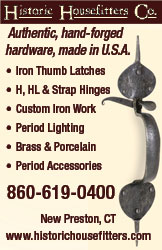
Home Structural Products & Services, Stairlifts
Structural Products & Services, Stairlifts
Furniture, Clocks,
Accessories
Antiques, Folk Art,
Fine Art, Auction Houses
THE GREAT CONNECTICUT TO VALLEY FORGE
CATTLE DRIVE
OF 1778
by Max H. Peters
|
| As far as I know, there is no cactus growing wild around Farmington and no sagebrush fields in the country just west of Wolcott. Those of us who grew up watching TV Westerns punctuated with commercials for Mister Clean, Charmin Bathroom Tissue and Brillcreme were subject to a highly fictionalized account of cattle drives. In the real world,one of the great cattle drives was from Connecticut to Valley Forge in February of 1778. For Clint Eastwood, substitute Epaphroditus Champion, son of Connecticut state commissary Colonel Henry Champion. General George Washington had directed Connecticut Governor Jonathan Trumbull to round up cattle and herd them to Valley Forge. Trumbull turned the job over to Henry Champion, from Colchester, who enlisted his twenty-two year old son and official assistantEpaphroditus as trailboss. With the help of patriot volunteers father and son put a wagon train together, rounded up 300 head of cattle and headed out in wintry weather. There is no record of what happened on the drive beside the route: west to King’s Ferry and across the Hudson, then across a dangerous part of New York infested with mounted bands of “cow-boys,” pro-British vigilantes who preyed on pro-Revolution families. Then across New Jersey where they managed to avoid British Army patrols, then across the Delaware, through country inhabited by pro-British Indians who would have loved getting the cattle, along with the bounties for the Yankee’s scalps. Finally, west of the Schuykill, they reached Washington’s starving troops. Likely they received a thunderous ovation at Valley Forge and received thanks from Washington himself. |
  |
Epaphroditus did report that the 12,000 troops at Valley Forge consumed the 300 head of cattle in five days. “You could have used any of the bones for a knife,” he wrote. |





